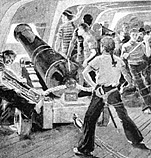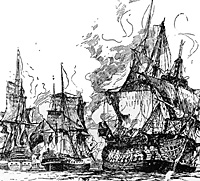
Play takes place by simultaneous turns either strategic turns (representing up to a month at a time) or tactical turns representing ten minutes each). In strategic terms, each turn starts with the umpire issuing an event card to each team. The teams then discuss what they want to do and the umpire adjudicates the results accordingly, perhaps breaking down the month into a series of sub-moves. These may include time sequences of any length down to an hour, with action taking place either on maps or on the table top.
In tactical turns, either use your own favourite wargame rules, or use these.
MOVEMENT
Ships are considered to be either in 'line' or 'sailling independently.' In line they gain advantages of firepower and, in particular, they prevent the enemy from breaking through and raking. But they must sail at the speed of the slowest ship and must obey orders. If they are 'sailing independently,' the player may indicate what he would like them to do, and in favourable cases they will be able to perform feats of Virtuosity -- the umpire to decide what they actually do.
Further from the wind than 110 degrees (i.e. 70 degrees into wind), the ship may not advance but must either tack 140 degrees straight across the wind in one turn, to end at an angle of 110 degrees from it (ie 70 degrees into it) on the opposite tack. Alternatively, the ship may wear back from facing close to the wind to sailing directly with it. In other types of move a ship may turn 22 degrees to either side for every inch forward, without losing way.
If a ship can turn into such a position that it might insert itself between two enemy ships sailing in line, and so rake them, it will be allowed to complete this manoeuvre only if its skill rating plus half a d6 score (rounded down) is less than the skill rating of the ship ahead of which is trying to pass, plus half a d6 score. If the ship fails to break the line in this way it must turn to pass alongside the enemy line, parallel to it.
A ship may voluntarily reduce speed by any distance in a turn (or accelerate up to maximum speed), provided that a precise distance is stated in advance. Halted ships drift to leeward by 1 or 2 inches, depending on wind speed. When there is no wind, there is no sailing.
| Movement rates | ||||||
|---|---|---|---|---|---|---|
| . | Light Wind | Strong Wind | ||||
| Number of Decks = | 3 | 2 | 1 | 3 | 2 | 1 |
| Sailing before the wind: (ship pointing in, or up to 75 degrees aside from, the wind's direction) | ||||||
| Move | 5" | 6" | 7" | 3" | 4" | 5" |
| Sailing close to the wind: (ship pointing between 75 degrees and 110 degrees away from the wind's direction) | ||||||
| Move | 3" | 4" | 5" | 1" | 2" | 3" |
COMBAT
 At any point in each turn, a ship may fire either or both its broadsides at enemy shipping within range (= 1 inch for short range, 4 inches for maximum range). The angle at which broadsides may be fired is up to 15 degrees on either side of 90 degrees from the firing ship's line of sail. The "raking angle" is up to 15 degrees on either side of the line of sailing of the target ship.
At any point in each turn, a ship may fire either or both its broadsides at enemy shipping within range (= 1 inch for short range, 4 inches for maximum range). The angle at which broadsides may be fired is up to 15 degrees on either side of 90 degrees from the firing ship's line of sail. The "raking angle" is up to 15 degrees on either side of the line of sailing of the target ship.
Roll one d6 per deck and deduct the Skill rating of the firing ship:
- Two dice points for fire at long range
- One point for fire from ships 'sailing independently'
Count one Damage Point inflicted on the enemy for any positive score, or one damage point plus a third of a mast down (ie deduct ten per cent from movement) if the score on any die is more than one, or as many damage points as there are on the die in the case of a rake at short range.
Each deck can absorb 4 Damage Points before being neutralised for fire. For any fire on the last remaining deck, roll again: If the result is a 1 or 2, the ship itself is in jeopardy! Roll again:
| Roll | Result |
|---|---|
| 1 | Blows up at once |
| 2 | Catches fire, burned out after 3 turns |
| 3 | Holed badly (sink in 6 turns) |
| 4-6 | Strikes colour (must be boarded, to capture, in 3 turns) |
 When adjacent to and touching an enemy ship, it may be grappled for 1-3 (add one if you are bigger: deduct one if you are smaller). Each side multiplies a die roll by its surviving number of decks, and the higher score is the winner. In general there are few hard and fast rules for
umpiring this game beyond the normal guidelines for umpiring all 'hidden movement'
games- i.e. use lots of common sense, and tell everyone everything they ought to know but
nothing they ought not know. In particular pay attention to the speed at which messages may
be transmitted from one force to another- and make sure an actual ship is sent to carry it
(unless it goes overland, eg from one coast of Corsica to another).
When adjacent to and touching an enemy ship, it may be grappled for 1-3 (add one if you are bigger: deduct one if you are smaller). Each side multiplies a die roll by its surviving number of decks, and the higher score is the winner. In general there are few hard and fast rules for
umpiring this game beyond the normal guidelines for umpiring all 'hidden movement'
games- i.e. use lots of common sense, and tell everyone everything they ought to know but
nothing they ought not know. In particular pay attention to the speed at which messages may
be transmitted from one force to another- and make sure an actual ship is sent to carry it
(unless it goes overland, eg from one coast of Corsica to another).
If in doubt, make up a story that is realistic and feasible within the conditions of the time, and favours one side or the other not because of your own personal whim, but only according to whether die rolls are favourable or not (but remember that the British are much better seamen than the French!).
The technical part of umpiring this game is mainly to do with matching French and British movements on a master map, until opposing forces come within visual range of each other. A vital element in this is the weather:
| Strategic Weather | ||||
|---|---|---|---|---|
| Die Score | 1/2/3 | 4 | 5 | 6 |
| Winter | NW | NE | SW | SE |
| Summer | SW | NW | SE | NE |
Roll a second die for the number of days this wind continues until the next roll for wind. The SE wind directions will determine the general speed at which movements can take place from one place to another (allow 200 miles per day if ship has wind directly behind, or 100 miles if ship is aiming between 75 and 110 ° of wind direction. Otherwise only 50 miles, or no move at all if trying to get out of port. Note that in this era fleets could often be forced to stay in port for weeks on end, by a headwind). Then roll a further die for each particular movement. It goes ahead as planned unless interrupted by a score of:
- 1/2: gale blows ship off course (in direction of another die roll).
3:becalmed for number of days shown on another die roll.
All ships of skill rating 3 or 4 roll a die for damage whenever they (a) leave a port, or (b) are in a gale: 1 2
- 1:Lose two masts in a gale, or suffer serious hull damage in port: roll again
for number of weeks needed to make repairs in nearest port that has reserves of naval stores.
2:Lose one mast in a gale, or suffer medium hull damage in port: roll again for number of days needed to make repairs in nearest port that has reserves of naval stores, then treble the number.
TACTICAL WEATHER
Whenever two opposing forces come within seven miles of each other, roll a die for visibility:
- 1: Quarter mile on map or 4" on table top
2: One mile on map or 12" on table top
3: Two miles on map or unlimited on table top
4-6: full seven miles on map (Transfer the action from map to table whenever appropriate)
Now roll again for wind direction as in 'strategic weather', above, but with a second die for the strength:
-
1 calm
2/3/4 light
5/6 strong
Finally roll for the number of hours (not days) the weather stays the same, before the next die rolls for weather are needed. Apart from Hidden Movement and Weather, the umpire is also responsible for issuing updates to the two sides at the start of each month. Note that there are British and French Updates.
More Noli
-
Noli Introduction
Noli Rules
British Updates
French Updates
Map (Western Section) Large file: 129K
Map (Eastern Section) Large file: 129K
Back to Battlefields Vol. 1 Issue 5 Table of Contents
© Copyright 1996 by Partizan Press.
This article appears in MagWeb (Magazine Web) on the Internet World Wide Web.
Other military history articles and gaming articles are available at http://www.magweb.com